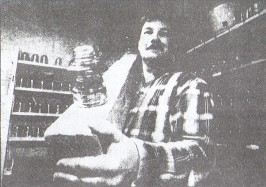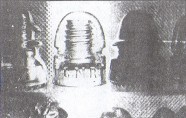To the undiscerning eye, glass insulators are oddly-shaped pieces that serve
no useful purpose in the modern age, save for catching sunlight in the window.
But to Steve Goodell of Carleton Place, and other collectors across North
America, insulators are prisms to the past as well as to light.
"You can
trace the evolution of the glass industry through the glass," Goodell says
of the domes used to insulate early telegraph, telephone and hydro wires.
The
clearest example of this is the threadless insulator. These were manufactured in
the early and mid-1800s and have no grooves to twist the insulator on to a pole.
Instead, adhesives such as tar or pitch were used.
After 22 years of collecting,
Goodell has just 10 threadless insulators in a collection that numbers in the
thousands.
Studying the history of insulators is Goodell's passion, says his
wife, Janet. "He just loves researching about them. He knows all about the
railway and glass companies, what ones made or used what insulators and in what
year."
In a curious coincidence, Goodell discovered through his research
that an ancestor, E. Cornell, was one of the first creators of the glass
insulator.
Goodell pores over old survey maps and railway timetables. and has
talked to a number of retired workers from railway and phone companies to learn
where old telegraph and telephone lines ran. Then the hobby historian goes to
the sites, often with others, to dig for insulators.
"There are basically
two kinds of collectors. The ones who actually go and walk the lines and dig,
and the ones with the thick pocketbooks. In my mind. they're not the true
collectors."
Insulators are a popular commodity internationally. In fact, says Goodell. some Americans make a living just from dealing in the
insulators.
Prices for insulators edge up in to the thousands: Goodell says a
Canadian collector recently paid $10,000 for an insulator, then sold it for
$12.000 just hours later. Goodell won't pay more than $100 cash for an
insulator. although he will trade several to get one.
Variables such as availability
or color affect value - - a difference in the shade of a color can drive up the
price and collectors must be wary of fraud.
To help identification. there are
periodicals published by and for collectors. The Canadian Insulator Collector was
started by Goodell. It's now published by Mark Lauckner and Russell Paton. Write to them care of the magazine at Mayne
Island, B.C. V0N 2J0.
The largest American periodical is Crown Jewels of the Wire, published by John and Carol McDougald, 5N941 Ravine Dr., St. Charles,
Illinois, 60175-8272. They have also written a history and guide to glass pin
type insulators. Call (708) 513-1544 for details.
Canadian collectors reach each
other informally through magazines and sales. says Goodell, and associate with a
number of American clubs. including the National Insulator Association. For
information, call Joe Beres at (216) 526-3478.


-- Pat McGrath, Citizen
Steve Goodell's research of the history of
glass insulators led to the
discovery that
an ancestor was one of the first founders
